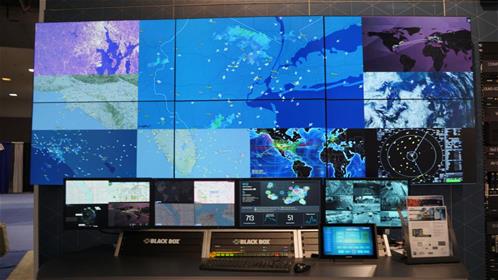Control Room operators typically need to monitor large amounts of information and interact with mission-critical systems. This often requires the need for simultaneously presenting the operator with multiple video or HMI sources. In some environments desktop monitors and a single large screen display may be sufficient, in other environments a large-scale video wall with multiple screens may be required to better support situational awareness across multiple operators.
There are essentially two ways to create a multi-window visual environment in a control room – with a multi-viewer or a video wall processor.
Multi-Viewers
Multi-viewers are generally purpose-built devices with embedded operating systems for viewing multiple windows on a single display. The number of windows typically ranges from 4-12. In the broadcast industry, multi-viewers scale to even more windows, but are more specialized in their video inputs and also display things like audio meters and advanced labelling. These broadcast-specific multi-viewers are not the subject here of comparison to video wall processors. A typical desktop multi-viewer will contain four images and ones used on larger displays might use more. Multi-viewers can be connected to any type of display device, including projectors, to create a single large, multi-window image.


Since multi-viewers can display multiple windows, most support various types of layouts such as quadview, picture-in-picture, and windowed, and the window sizes can sometimes be adjusted as desired by the operator. Some advanced multi-viewers also support keyboard and mouse functionality so that the operator can have full KVM control of multiple sources displayed on a single screen, and some also might have more physical inputs than supported output windows which allows for a limited switching type of function. Multi-viewers generally support external control through either a serial or Ethernet interface to make basic operation easy through a push-button or touchpad device. A growing trend is for multi-viewers to also directly decode H.264 streams.
Video Wall Processors
Control room video wall processors behave similar to multi-viewers in creating a multi-window display, but are designed to create that output across a range of multi-display combinations such as 1x4, 2x3, 4x5, etc. Smaller scale video wall processors are generally designed around embedded operating systems while most of the large-scale video wall processors are designed around Windows platforms. IP-based platforms are also based on embedded operating systems. Centralized video wall processors are generally based on adding cards to one or more system chassis while distributed, IP-based processors are based on having one transmitter per source and one receiver per display. Either architecture can provide a highly scalable solution.

Control room video wall processors support having essentially an unlimited number of windows based on practical viewing size, not just a pre-defined limit (i.e. 4-12) as is the case with multi-viewers. While video wall processors can also be controlled through an external control API by push-button and touchpad controllers for switching layouts and content sources, there is typically a separate user interface for managing the system that is more capable than an external control device. The software interface can support various levels of permissions with some advanced system options being limited to administrators, with users only controlling the video wall with external control devices. Multiple video walls can also be administered from a single system.
Content sources can be duplicated multiple times inside the processor and displayed in different windows simultaneously with different parameters such as cropped, frame rate, color hue, etc. This enables subsets of content from a single source to be viewed in separate windows or on separate video walls.
The larger-scale systems also have the capability to receive H.264 streams from hundreds of video cameras. And with so many sources to potentially view, content carousels can be configured to create groups of content that are rotated inside of a window with preset rotation timing between each source. In order to eliminate content gaps to display the next camera in the sequence, simultaneous decoding is performed on the active and next stream.
In addition to user permission levels, some control room video wall processors also support activity logging to capture changes to the wall such as user log-ins, parameter configuration changes, layout changes, source switching, and more.General Comparison of Control Room Multi-viewers and Video Wall Processors
Multi-viewer | Video Wall Processor | |
# of windows | 4-12 typical | Unlimited |
Multi-Display | No | Yes |
Wall layout | N/A | Multiple arrangements |
Keyboard/mouse control | Some | Some |
Multiple wall control | No | Some |
Window scaling | Limited | Unlimited |
Operating system | Embedded | Windows or embedded |
External control interface | Yes | Yes |
Activity logging | No | Some |
Architecture | Single chassis | Single- or Multi-chassis, or Distributed (IP) |
Visit our product and solutions web pages to learn more about multi-viewers, video wall processors, and control room solutions.